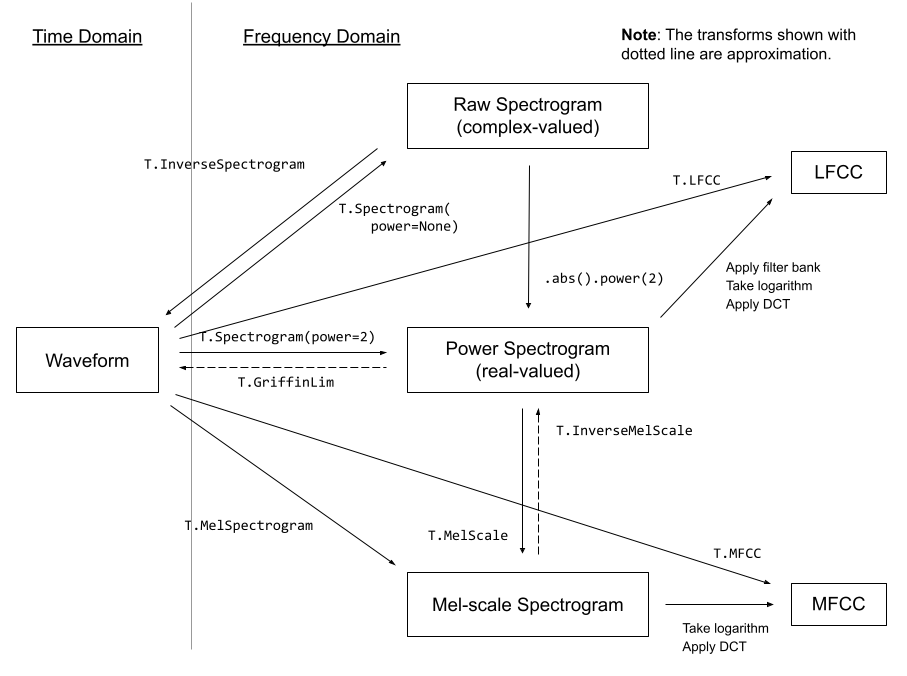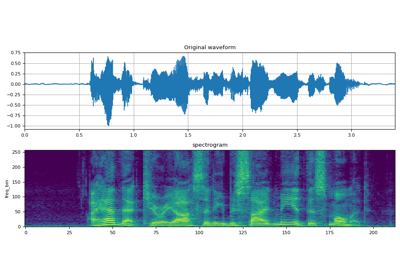torchaudio.transforms¶
torchaudio.transforms module contains common audio processings and feature extractions. The following diagram shows the relationship between some of the available transforms.

Transforms are implemented using torch.nn.Module. Common ways to build a processing pipeline are to define custom Module class or chain Modules together using torch.nn.Sequential, then move it to a target device and data type.
# Define custom feature extraction pipeline.
#
# 1. Resample audio
# 2. Convert to power spectrogram
# 3. Apply augmentations
# 4. Convert to mel-scale
#
class MyPipeline(torch.nn.Module):
def __init__(
self,
input_freq=16000,
resample_freq=8000,
n_fft=1024,
n_mel=256,
stretch_factor=0.8,
):
super().__init__()
self.resample = Resample(orig_freq=input_freq, new_freq=resample_freq)
self.spec = Spectrogram(n_fft=n_fft, power=2)
self.spec_aug = torch.nn.Sequential(
TimeStretch(stretch_factor, fixed_rate=True),
FrequencyMasking(freq_mask_param=80),
TimeMasking(time_mask_param=80),
)
self.mel_scale = MelScale(
n_mels=n_mel, sample_rate=resample_freq, n_stft=n_fft // 2 + 1)
def forward(self, waveform: torch.Tensor) -> torch.Tensor:
# Resample the input
resampled = self.resample(waveform)
# Convert to power spectrogram
spec = self.spec(resampled)
# Apply SpecAugment
spec = self.spec_aug(spec)
# Convert to mel-scale
mel = self.mel_scale(spec)
return mel
# Instantiate a pipeline
pipeline = MyPipeline()
# Move the computation graph to CUDA
pipeline.to(device=torch.device("cuda"), dtype=torch.float32)
# Perform the transform
features = pipeline(waveform)
Please check out tutorials that cover in-depth usage of trasforms.
Utility¶
Turn a tensor from the power/amplitude scale to the decibel scale. |
|
Encode signal based on mu-law companding. |
|
Decode mu-law encoded signal. |
|
Resample a signal from one frequency to another. |
|
Add a fade in and/or fade out to an waveform. |
|
Adjust volume of waveform. |
|
Measure audio loudness according to the ITU-R BS.1770-4 recommendation. |
|
Scales and adds noise to waveform per signal-to-noise ratio. |
|
Convolves inputs along their last dimension using the direct method. |
|
Convolves inputs along their last dimension using FFT. |
|
Adjusts waveform speed. |
|
Applies the speed perturbation augmentation introduced in Audio augmentation for speech recognition [Ko et al., 2015]. |
|
De-emphasizes a waveform along its last dimension. |
|
Pre-emphasizes a waveform along its last dimension. |
Feature Extractions¶
Create a spectrogram from a audio signal. |
|
Create an inverse spectrogram to recover an audio signal from a spectrogram. |
|
Turn a normal STFT into a mel frequency STFT with triangular filter banks. |
|
Estimate a STFT in normal frequency domain from mel frequency domain. |
|
Create MelSpectrogram for a raw audio signal. |
|
Compute waveform from a linear scale magnitude spectrogram using the Griffin-Lim transformation. |
|
Create the Mel-frequency cepstrum coefficients from an audio signal. |
|
Create the linear-frequency cepstrum coefficients from an audio signal. |
|
Compute delta coefficients of a tensor, usually a spectrogram. |
|
Shift the pitch of a waveform by |
|
Apply sliding-window cepstral mean (and optionally variance) normalization per utterance. |
|
Compute the spectral centroid for each channel along the time axis. |
|
Voice Activity Detector. |
Augmentations¶
The following transforms implement popular augmentation techniques known as SpecAugment [Park et al., 2019].
Apply masking to a spectrogram in the frequency domain. |
|
Apply masking to a spectrogram in the time domain. |
|
Stretch stft in time without modifying pitch for a given rate. |
Loss¶
Compute the RNN Transducer loss from Sequence Transduction with Recurrent Neural Networks [Graves, 2012]. |
Multi-channel¶
Compute cross-channel power spectral density (PSD) matrix. |
|
Minimum Variance Distortionless Response (MVDR) module that performs MVDR beamforming with Time-Frequency masks. |
|
Minimum Variance Distortionless Response (MVDR [Capon, 1969]) module based on the relative transfer function (RTF) and power spectral density (PSD) matrix of noise. |
|
Minimum Variance Distortionless Response (MVDR [Capon, 1969]) module based on the method proposed by Souden et, al. [Souden et al., 2009]. |
